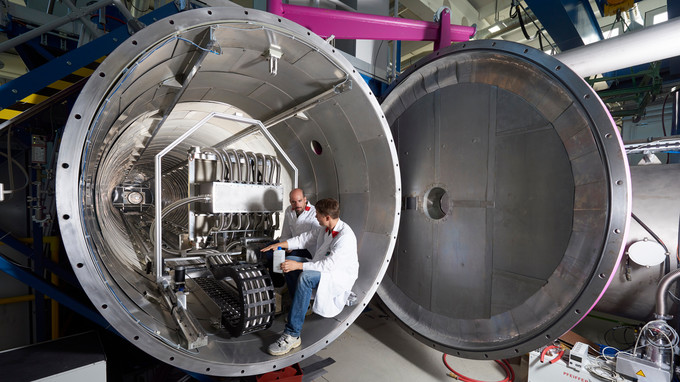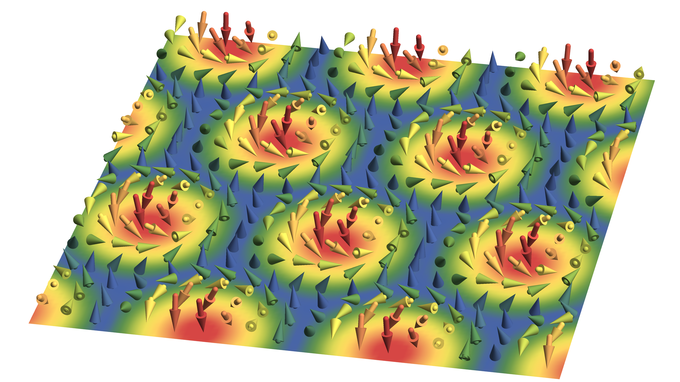Magnetische Wirbel: doppelt interessant
Erstmals zwei magnetische Skyrmionenphasen in einem Material entdeckt
2018-07-11 – Nachrichten aus dem Physik-Department

Strudel kennt jeder aus der Badewanne: Wenn das Wasser abgelassen wird, bilden sie sich kreisförmig um den Abfluss. Solche Wirbel sind im Allgemeinen sehr stabil. Ähnliche Strukturen treten auch in magnetischen Systemen auf. In magnetischen Wirbeln ordnen sich die magnetischen Momente kreisförmig an. Diese sogenannten Skyrmionen sind nicht nur für die Grundlagenforschung sehr interessant – aufgrund ihrer Stabilität und geringen Größe könnten sie auch für die Entwicklung zukünftiger Magnetspeicher eine Rolle spielen.
Auch deshalb werden die magnetischen Wirbel aktuell intensiv erforscht. Die Frage, wann und wo sie auftreten, ist von besonderem Interesse. Ein Forscherteam der TU München, der Universität zu Köln und der TU Dresden konnte nun erstmals zeigen, dass magnetische Skyrmionen aufgrund unterschiedlicher Mechanismen mehrfach im gleichen Material auftreten können. In der aktuellen Ausgabe der Fachzeitschrift Nature Physics berichtet es von deren Existenz in dem chiralen Magneten Cu2OSeO3 in der Nähe des absoluten Nullpunkts (-273,15 °C). Dazu muss jedoch ein Magnetfeld in eine bestimmte Raumrichtung angelegt werden.
Kleine Magnetstrukturen für kompakte Magnetspeicher?
„Skyrmionen finden sich normalerweise nur in einem einzelnen Bereich von Parametern, also in einem bestimmten Temperaturbereich oder einem Bereich magnetischer oder elektrischer Feldstärke. So ist das zumindest für alle Materialien in denen diese bislang beobachtet wurden,“ erläutert Professor Christian Pfleiderer vom Physik-Department der Technischen Universität München, der Leiter des Forschungsprojekts.
„Das bedeutet natürlich eine Einschränkung für die Herstellung und technische Nutzung von Skyrmionen, da sie nur stabil sind, wenn man die exakten physikalischen Parameter (z. B. Druck, Spannung oder Feld) zunächst findet und dann einhält. Jetzt haben wir in ein und demselben Material zwei unterschiedliche Skyrmionphasen entdeckt, die zwei getrennte Parameterbereiche aufweisen. Der neue Mechanismus galt als sehr schwach. Jetzt zeigt sich, dass es wesentlich mehr Möglichkeiten gibt Skyrmionen zu erzeugen und kontrollieren als wir bisher dachten.”
Zweite Skyrmionenphase bei ganz tiefen Temperaturen
Alfonso Chacon entdeckte die neue Phase, als er an der Forschungs-Neutronenquelle der TUM die metastabilen Eigenschaften einer bereits bekannten Skyrmionenphase untersuchte und erklärt: „Dieses metabstabile Verhalten interessiert uns, weil wir daraus die Ursachen und Stärke der Stabilität der magnetischen Wirbel bestimmen können. Dies erlaubt zu verstehen, wie diese erzeugt oder gelöscht werden können. Bei diesen Messungen ist uns die neue Phase dann aufgefallen.”
„Bei tiefen Temperaturen spielt die Quantenphysik eine immer größere Rolle“, erläutert Dr. Markus Garst vom Institut für Theoretische Physik der TU Dresden. „Diese beeinflusst auch die physikalischen Eigenschaften der magnetischen Skyrmionen. Unsere Forschungsergebnisse erlauben es uns, Quantenwirbel in Magneten gezielt zu untersuchen.“
„Wir forschen schon seit gut einem Jahrzehnt zu Skyrmionen, am aktuellen Projekt seit etwa anderthalb Jahren, und haben eine tolle und erfolgreiche Zusammenarbeit zwischen den beteiligten Gruppen,“ erklärt Dr. Garst. „Die Münchner Kollegen machten ihre Beobachtungen mit Hilfe von Neutronenstreuung, die es erlaubt, magnetische Strukturen sichtbar zu machen. Wir haben dann in Zusammenarbeit mit Lukas Heinen und Achim Rosch aus Köln die experimentellen Ergebnisse theoretisch erklären können.“ Diese enge Kooperation zwischen Experiment und Theorie machte diese wissenschaftliche Entdeckung erst möglich.
Weitere Informationen
Die Entdeckung und Untersuchung dieser magnetischen Phasen gelang an der Kleinwinkelneutronenstreuanlage SANS-1 des Heinz Maier-Leibnitz Zentrums an der Forschungs-Neutronenquelle Heinz Maier-Leibnitz (FRM II) der Technischen Universität München.
Die Forschungsarbeit wurde von der Deutschen Forschungsgemeinschaft im Rahmen der Sonderforschungsbereiche SFB 1143 „Correlated Magnetism: From Frustration To Topology“ und SFB 1238 „Control and Dynamics of Quantum Materials“ sowie des TRR80 „From Electronic Correlations to Functionality“ gefördert. Die Europäische Union förderte das Projekt im Rahmen des ERC-Grants TOPFIT und die TUM Graduate School unterstützte einen Teil der Autoren.
- Redaktion
- Dr. Johannes Wiedersich
Veröffentlichung
Verwandte Meldungen
Kontakt
- Prof. Dr. Christian PfleidererTechnische Universität MünchenJames-Franck-Str. 185748 GarchingTel.: +49 89 289-14720E-Mail: christian.pfleiderer@tum.de
- PD Dr. Markus GarstInstitut für Theoretische PhysikTU Dresden01062 DresdenTel.: +49 351 463 32847E-Mail: markus.garst@tu-dresden.de
- Prof. Dr. Achim RoschInstitut für Theoretische PhysikUniversität zu KölnTel.: +49 221 470 4994E-Mail: rosch@thp.uni-koeln.de
